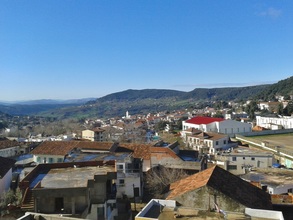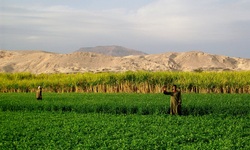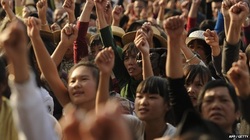The beach is a tourist hotspot across the Islamic world, attested to by the long line of Lebanese, Gulf & Turkish restaurants that line it, and the ginger Pashtuns who fill the Pakistani cafe. There's a posh marina with a Zara and policemen who run face control on anyone deigning to come close. Agadir is not like other places, but it is like every place.
|
Agadir is not like other places. Utterly destroyed in an earthquake in the 60s, it has been rebuilt in the international style, a mix of softish brutalism that wouldn't seem out of place in Coventry were the sun to ever shine, and the clean bold lines of modernism that Morocco does so well.
The beach is a tourist hotspot across the Islamic world, attested to by the long line of Lebanese, Gulf & Turkish restaurants that line it, and the ginger Pashtuns who fill the Pakistani cafe. There's a posh marina with a Zara and policemen who run face control on anyone deigning to come close. Agadir is not like other places, but it is like every place.
0 Comments
 View from my balcony Trundeling through the Tunisian countryside this time, I saw what would have made the Romans feel at home. Great, wide bowls of wheatfields, broken up with the occasional olive plantation, or with avenues of straight poplars leading to French built manors on top of cols. Here and there an ignored triumphal arch or toppled column marked their presence. Only a faint backdrop of twisted mountains suggested you weren’t on the northern side of the Mediterranean. I’d been surprised at how verdant Egypt had been, but it at least had the decency to look tropical, all palm trees and sugar cane. Despite being on the same latitude as Gibraltar, northern Tunisia looked more like France or perhaps southern Tuscany. Things got even weirder when I reached my destination, the mountains overlooking Algeria around the village of ‘Ain Draham. Here the profusion of pine and heather lent an almost Scottish feel to the highlands, one helped by the extreme changeability of the weather. I could go for a walk in glorious sunshine, sit out a hailstorm in a café, then walk home through sleet and snow. The village itself had a slight alpine feel, no doubt because the French had built it initially as a hill-station to escape the heat. There were lots of beautiful old buildings with red, sloping roofs and contrasting green highlights. Sadly, as it’s cheaper to build a new house than maintain an old one, Ave. Habib Bourguiba was lined with old wrecks, and Arab sprawl was starting to fill the valleys below. Still, it hadn’t quite reached tipping point, and the view from my balcony whilst the sun was shining was spectacular. It was time to get out of Tunis. It wasn’t that it was a bad city. On the contrary, it was actually reasonably beautiful, in a shabby sort of way. The streets were lined with bougainvillea, and after they suddenly cut all the foliage down one day, you could see that it wasn’t a slouch architecturally either. It all needed a lick of paint, but the Ville Nouvelle was an interesting mix of Art Nouveau, Art Deco, and the slow bleed of the former into the latter. On some streets you could literally watch the march of architectural fashion, as curves became less floral and more abstract on each subsequent building.
I think part of the reason it looked so decent was the light out here. It really is amazing. I’m not sure if it has to do with the latitude or some optimum level of dust to moisture, but it was particularly clear and made everything look wonderful. If I didn’t hate the word, I’d describe it as limpid. It also led to a remarkable range of clouds, painted in far more than fifty shades of grey, with detours through blue and purple, and highlights of white, pink and orange. I didn’t pay enough attention in Geography class to describe the moosemash of different types of clouds, or why they arose, but they were astounding. I can just see the next advertising campaign – come to Tunisia and see our clouds! The kids of Carthage have a game they like to play when they ride the TGM, a suburban train line that links Tunis to its extended suburbs. When the train starts to leave, two friends hold the doors open, whilst the third runs along beside it, and, at the last moment, as the train starts going too fast for them and they almost run out of platform, they jump on. So I didn’t think anything of it when some teenagers started doing it as I caught the train back towards town after a day filming on the ancient sites.
I don’t think either when instead of jumping on, the kid grabs my bag: I just jump off after him. The doors catch my shoulder as they close, and I hop along as best I can as the train accelerates. With a final pull I’m free, but I’m spinning round, and trying to run as fast as I can backwards to stop myself falling over. For the briefest moment there’s an illusion of control, and then my feet go over the end of the platform and I’m pedalling like a cartoon character as I plummet the five feet or so to the tarmac. I’m not thinking when I roll away from the vast metal wheels that grind past my elbow. I’m not thinking when I jump up and run back into the station – adrenalin is a hell of a thing – pushing screaming bystanders out of the way, gradually becoming aware I’m only wearing one shoe, and that the fact everything’s blurry means I’ve lost my glasses. The boys are gone. My bag is gone. My camera, all my photographic equipment, my brand new kindle, it’s all gone. It’s all gone.  It's perhaps hard to remember the hope we felt during the first flushes of the Arab Spring, when I, for one, was glued to the news websites, reading their live streams and dreaming of real change. Despite the good news coming out of Egypt at first, it seems like the army have been playing for time, hoping that the people would grow tired of revolution and settle for something that doesn't really shift the status quo. It can feel odd cheering on the Muslim Brotherhood, but despite what a raft of internet warriors would have you believe, there are many shades of Islamism, and the Freedom and Justice Party so far have proven closer to the Turkish sort than the Iranian. So, how to keep the army busy and out of politics? With nearly half a million active soldiers (the 10th largest army in the world, who knew?) they certainly have plenty of personnel. Perhaps if the UN were serious about securing peace in Syria some of these guys could be sent over there, rather than the paltry 300 observers on the last mission. I can't say it's a flawless plan - the Alawites in Syria might be a little worried about letting a largely Sunni force in, for a start. Then again, Syria and Egypt were the same country in the lifetimes of most officers, if not of the grunts. And generals with some proper action on their hands might be less inclined to spend all their time defending their personal fiefdoms. A pipe dream at best, but given that its clear which side Saudi Arabia is on, it's a more practical solution than asking them to step in and keep the peace. The first thing that struck me when I arrived in Egypt proper (as opposed to the Sinai), was just how lush and verdant it was. Throughout history Egypt has been the breadbasket of empires, and driving through the fertile delta region where blocks of flats squeeze together to leave as much field space as possible it's easy to believe. With this and the entire Nile Valley under cultivation since the Aswan Dam came into being, the contrast with much of the rest of the Middle East & North Africa couldn't be more marked.  Growing sugar in the Nile Valley Perhaps that's why there's been such interest in a couple of sentences thrown into a report on malnutrition by The Economist: Egypt’s agricultural value-added per person rose more than 20% in 1990-2007. Yet both malnutrition and obesity rose—an extremely unusual combination. Some bloggers have been swift to see the not quite so invisible hand of capitalism slapping away. Certainly meat has been in increasing demand from the new Egyptian middle classes, with all the inefficiency of food use that implies. Egypt has also been switching increasingly from growing wheat to growing cash crops, and the traditional fellah tending his little patch of land has been displaced by increasing levels of agribusiness.  It’s always been a great source of dismay to me that despite predicting the financial crisis in ’07, I didn’t have the foresight to write anything down and thus claim my place amongst the economic gurus of our age. Admittedly the horror stories I would describe to friends were a little more rooted in a post apocalyptic imagination than a sound grasp of Credit Default Swaps and their likely implications, but I thought it fitting that I get my current vague forebodings down in writing at the start of this blog so that I don’t miss another chance to claim my rightful title as Seer Extraordinaire. Whilst it’s hardly news to say ‘Keep your eyes on China’, I have a feeling that in the next few years, the meteoric rise of the Dragon may stutter, or indeed change direction. I must confess to having little insider knowledge – I’ve only spent a couple of weeks in China, and all of that was within Xinjiang. However, as with the financial crisis, my belief that something will change comes from looking at everything in the public domain and deciding something doesn't make sense. If you asked the man in the street about China, then you might expect to hear something about its inexorable rise. Yet there’s something very rotten in this state that comes to the surface with only a little digging. We have grown immured to the constant strikes and protests, but it still comes as a shock to hear that an estimated 90,000 happen every year. The current spate of immolations in Tibet will probably be controlled like the riots in Xinjiang before them, but the anger of the Han Chinese majority may be harder for officials to contain. |
A BlogLittle ideas that spin through my mind. Archives
May 2020
Categories
All
|

 RSS Feed
RSS Feed
